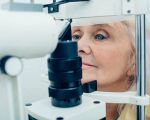- 1-Understanding-Chronic-Dry-Eye-Syndrome
- 2-Common-Causes-and-Risk-Factors
- 3-Symptoms-and-Diagnosis-of-Chronic-Dry-Eye
- 4-Effective-Treatments-for-Chronic-Dry-Eye-Syndrome
- 5-Lifestyle-Changes-and-Home-Remedies
- 6-When-to-See-a-Specialist-and-Finding-Help-at-Eye-Docs
1. Understanding Chronic Dry Eye Syndrome
Chronic dry eye syndrome is a persistent condition where the eyes do not produce enough tears or the tears evaporate too quickly, leading to discomfort, redness, and potential damage to the eye’s surface. Unlike occasional dryness, chronic dry eye can significantly affect quality of life, making simple tasks like reading or using a computer challenging.
Understanding how to treat chronic dry eye syndrome is essential for managing symptoms and preventing complications. This condition requires a comprehensive approach tailored to each individual's needs.
2. Common Causes and Risk Factors
Several factors contribute to chronic dry eye, including aging, environmental conditions like wind or dry air, prolonged screen time, certain medications, and underlying health issues such as autoimmune diseases. Hormonal changes, particularly in postmenopausal women, also increase risk.
Recognizing these causes helps in developing an effective treatment plan and adopting preventive measures.
3. Symptoms and Diagnosis of Chronic Dry Eye
Symptoms typically include persistent dryness, burning sensations, itching, blurred vision, and sensitivity to light. Some patients experience excessive tearing as a reflex response.
Diagnosis involves a thorough eye examination, tear film tests, and sometimes imaging techniques. Eye care professionals evaluate tear production and evaporation rates to determine severity.
4. Effective Treatments for Chronic Dry Eye Syndrome
Treatment varies based on severity and cause but often includes artificial tears to lubricate eyes, prescription medications like cyclosporine to reduce inflammation, and punctal plugs to conserve tears.
Advanced therapies such as intense pulsed light (IPL) therapy and lipiFlow help address underlying gland dysfunction. Regular follow-up ensures treatment efficacy and symptom relief.
5. Lifestyle Changes and Home Remedies
Incorporating simple lifestyle adjustments can significantly alleviate chronic dry eye symptoms. These include taking regular breaks during screen use, using humidifiers to maintain moisture, wearing protective eyewear outdoors, and staying hydrated.
Warm compresses and eyelid massages can improve gland function and tear quality. Incorporating omega-3 fatty acids through diet or supplements may also benefit some patients.
6. When to See a Specialist and Finding Help at Eye Docs
If symptoms persist despite home care or worsen over time, consulting an eye specialist is crucial. Early intervention can prevent complications such as corneal damage.
Eye Docs offers comprehensive evaluations and personalized treatment plans for chronic dry eye syndrome. With access to advanced diagnostic tools and therapies, Eye Docs helps patients achieve lasting relief and improved eye health.








